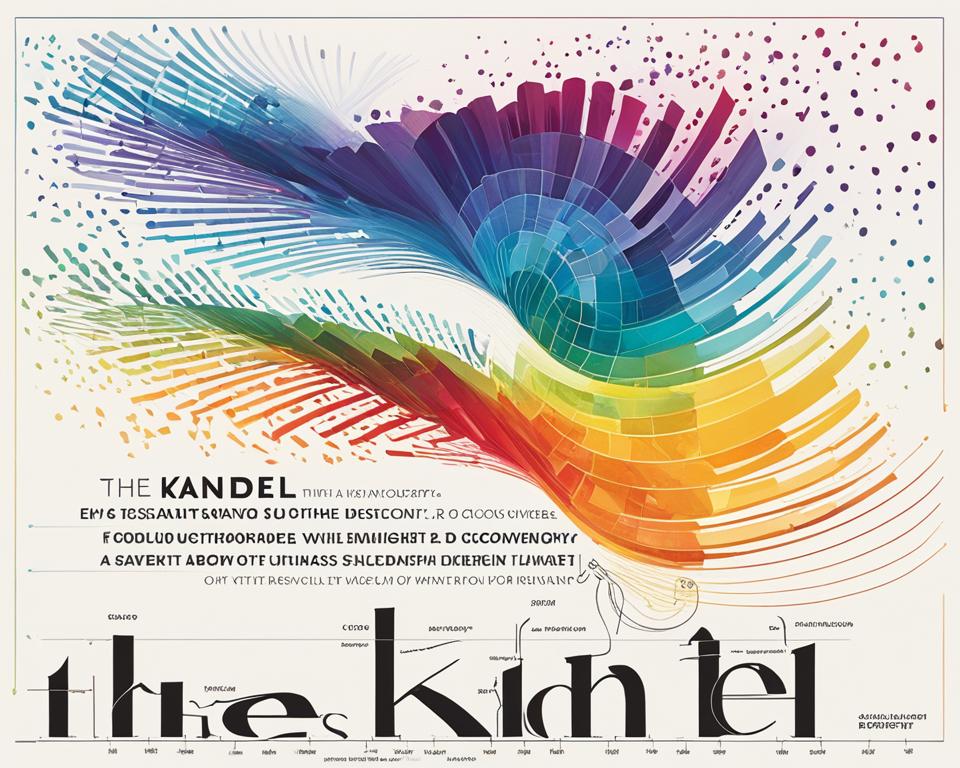In this audiobook review, we delve into Eric Kandel’s profound journey of discovery in “The Age of Insight,” exploring the world of mind and art. Kandel’s in-depth research provides valuable insights into the complex relationships between the brain, emotions, and artistic expression.
Key Takeaways:
- Kandel’s audiobook explores the intersection of mind and art, providing a deep understanding of human perception and creativity
- The production quality and narration of the audiobook are highly effective in conveying Kandel’s points
- Kandel’s research and insights have significant implications in various fields, including psychology, neuroscience, and art
- Understanding the historical and cultural contexts of art and neuroscience enhances our appreciation of Kandel’s ideas
- “The Age of Insight” provides a balanced overview of the strengths and weaknesses of Kandel’s arguments
Introduction to ‘The Age of Insight’
If you are interested in exploring the intersection of mind and art, ‘The Age of Insight’ audiobook by Eric Kandel is an excellent choice for your listening pleasure. Kandel, a Nobel Prize-winning neuropsychiatrist, delves into the world of mind and art through a profound journey of discovery.
Kandel’s book offers a fascinating exploration of the biological underpinnings of artistic genius and creative thought. He examines the critical roles that perception and emotion play in the artistic process and how they are intertwined with our understanding of neural and cognitive functions.
Through his research and insights, Kandel sheds light on the mysteries of human perception and creativity, providing a unique perspective on the relationship between mind and art. In the following sections, we will provide an overview of the key themes and concepts addressed in ‘The Age of Insight,’ analyze the audiobook’s strengths and weaknesses, and explore the implications and applications of Kandel’s work.
Key Concepts Explored in the Audiobook
In “The Age of Insight,” Eric Kandel delves into the intersection of mind and art, exploring how scientific research informs our understanding of human creativity. One of the key concepts explored in the audiobook is the idea of perception, and how it shapes our experiences of art and the world around us.
Kandel also discusses the role of emotions in artistic expression, and how the brain processes and responds to different forms of sensory input. Through his research, he sheds light on the complex nature of creativity, and the ways in which it is shaped by both biological and cultural factors.
“The brain is not a passive recorder of experience, but an active interpreter, constantly searching for meaning and purpose in the world around us.” – Eric Kandel
Another central theme of the audiobook is the importance of context and history in understanding the cultural significance of art. Kandel examines how social and political factors shape our perceptions of art, and how historical events can influence artistic movements and styles.
Through these key concepts, Kandel offers a unique perspective on the intersections between science, art, and culture. By examining the ways in which the brain processes sensory information and generates creative output, Kandel’s research provides valuable insights into the nature of human experience and perception.
Critical Analysis of “The Age of Insight”
In this section, we will provide a critical analysis of Eric Kandel’s audiobook, “The Age of Insight,” focusing on the strengths and weaknesses of his arguments. Kandel explores the intersection between art and neuroscience, offering profound insights into human perception and creativity. However, his writing can be dense and challenging to follow, requiring a high level of background knowledge in the field.
One of the strengths of Kandel’s work is his ability to connect research from various fields, including biology, psychology, and art history. This interdisciplinary approach provides a rich understanding of the mind and the creative process, highlighting the complex relationships between these areas.
However, some readers may find his style of writing challenging, particularly if they do not have a strong background in the sciences. Additionally, while Kandel provides detailed case studies and examples, some of his arguments can be difficult to follow without a significant amount of context.
Overall, while “The Age of Insight” offers valuable insights into the human mind and creativity, readers should approach this audiobook with some familiarity with the science and history of art to fully appreciate its impact and significance.
Narration and Production Quality
In assessing the audiobook’s narration and production quality, we were impressed with the overall experience. The narrator’s voice talent was engaging and well-suited to the subject matter. Their pacing was well-judged, allowing the listener’s mind to fully absorb the content without feeling rushed. On the other hand, the audiobook’s production quality was of a high standard, with clear audio and no discernible background noise or disruptions that distract from the narration.
The audiobook’s format provides a unique perspective, and it is satisfying to experience the author’s nuanced tone and delivery artfully merged with a pleasurable listening experience. We, therefore, highly recommend “The Age of Insight” audiobook for anyone who wants to take their audiobook experience to the next level and learn more about the intersection of neuroscience and the arts.
Exploring the Mind-Body Connection
In “The Age of Insight,” Eric Kandel explores the intricate relationship between the brain and the body, particularly in the context of emotions and artistic expression. Kandel’s extensive research into the neurobiological mechanisms of perception and creativity sheds new light on the mind-body connection, unraveling the secrets behind the human experience.
One of the most significant insights Kandel presents is the idea that the mind and body are intimately linked, with emotional experiences manifesting as bodily reactions. For example, Kandel explains how viewing an artwork can evoke powerful emotions in the viewer, leading to physical responses such as increased heart rate and changes in brain activity. This connection between the mind and body highlights the significance of art in exploring our emotions and understanding the human experience.
Moreover, Kandel discusses the role of the brain in shaping our perceptions of the world around us. As he notes, our sensory experiences are not isolated events but rather are shaped by the context in which they occur. This insight demonstrates the crucial connection between the mind, body, and environment, providing a valuable contribution to the study of perception.
Kandel’s work on the mind-body connection has important implications for fields beyond neuroscience and psychology. By exploring the neural mechanisms of artistic expression, Kandel’s research demonstrates how art has the power to evoke emotions and communicate complex ideas. This insight has relevance in fields such as education, where educators can use art to convey complex concepts and engage students in the learning process.
Art, Science, and Creativity
Eric Kandel’s “The Age of Insight” delves into the fascinating intersection of art, science, and creativity. Kandel’s research and insights provide a unique perspective on how these disciplines intertwine and have profoundly impacted human culture.
One of the key takeaways from Kandel’s audiobook is the understanding that creativity is not solely a “right-brain” activity. As Kandel notes, “creative geniuses are made not born.” Through various case studies and real-life examples, Kandel shows the ways in which science and creativity are inextricably linked.

Kandel’s findings also shed light on the ways in which historical and cultural context influences artistic expression. For example, Kandel discusses how the Vienna School, a group of thinkers and artists in the early 20th century, explored the relationship between psychology and art. Kandel emphasizes the importance of understanding this context in order to fully appreciate the meaning and significance of art.
Furthermore, Kandel’s audiobook offers insights into the role of the brain and emotions in artistic expression. By exploring the mind-body connection, Kandel provides a deeper understanding of how artists translate their emotions and experiences into their work. As Kandel states, “The power of art itself comes from the artist’s capacity to communicate feelings and thoughts.”
Overall, “The Age of Insight” is a thought-provoking study of the relationship between art, science, and creativity. Kandel’s insights offer a greater appreciation of the depth and complexity of human expression.
The Importance of Context and History
In Eric Kandel’s audiobook, “The Age of Insight,” historical and cultural context is paramount in understanding the intersection of art and neuroscience. The study of art and its impact on human perception of the world is a complex and multifaceted subject, deeply rooted in culture and history.
It is essential to explore how different historical and cultural contexts have influenced the creation and interpretation of art. For instance, the symbolic meanings and cultural significance attributed to different types of art vary significantly across different cultures and epochs.
Understanding this diversity promotes a broader understanding of our own culture and history, allowing for a more nuanced appreciation of diverse perspectives and forms of artistic expression. Moreover, exploring historical and cultural contexts can enhance our understanding of how scientific developments in neuroscience have been shaped by cultural and societal forces.
Kandel’s audiobook explores these themes extensively, shedding light on the broad range of social, cultural, and intellectual influences that have contributed to our understanding of the mind and art.
As Kandel points out, neuroscience and art are intertwined in complex ways, and it is only through understanding the historical and cultural context that we can fully appreciate the significance of their interactions.
Case Studies and Real-Life Examples
In “The Age of Insight,” Eric Kandel provides a wealth of case studies and real-life examples that illustrate his ideas and concepts. One such case study is the work of Gustav Klimt, an artist whose paintings were heavily influenced by the Vienna School of Medicine’s research on the human mind and body. Kandel argues that exploring such examples showcases the links between art and science, highlighting the ways in which advancements in neuroscience can inform artistic expression.
Another real-life example that Kandel explores is the case of patient H.M., who underwent surgery to remove part of his brain to treat his seizures. Despite the success of the surgery, H.M. experienced profound memory loss. Kandel argues that this case study provides invaluable insights into the workings of memory and perception, and how the brain processes and creates memories.
Overall, the case studies and real-life examples presented in “The Age of Insight” offer compelling illustrations of Kandel’s ideas and concepts. They serve to deepen our understanding of the complex relationship between mind and art, shedding new light on the nature of human perception and creativity.
Implications and Applications
Eric Kandel’s “The Age of Insight” offers a multitude of implications and applications in various fields such as psychology, neuroscience, and art. Kandel’s profound journey of discovery and exploration of the intersection of mind and art presents a plethora of opportunities for further study and research.
One of the implications of Kandel’s work is the significance of context and history in enhancing our understanding of human perception and creativity. By exploring the historical and cultural context of art and neuroscience, we can gain a deeper appreciation of the complexities and nuances of artistic expression.
Kandel’s research also provides valuable insights into the mind-body connection. By understanding the links between the brain, emotions, and artistic expression, we can gain a deeper understanding of how creativity impacts our mental and physical well-being.
The applications of Kandel’s research extend beyond the realm of science and art, providing practical insights into areas such as education and therapy. By understanding the workings of the brain and the role of artistic expression in human development, we can develop new approaches to education and therapy that are more holistic and effective.
“The revelations and insights presented in ‘The Age of Insight’ have a great potential to influence and shape our understanding of the world of mind and art for years to come.”
The revelations and insights presented in “The Age of Insight” have a great potential to influence and shape our understanding of the world of mind and art for years to come.
Critiques and Counterarguments
Despite the groundbreaking insights provided by Eric Kandel’s audiobook, “The Age of Insight,” there have been critiques and counterarguments raised regarding his work.
One critique is that Kandel’s exploration of the mind-body connection is overly reductionist, failing to fully appreciate the unique complexities and nuances of human experience. Some have argued that Kandel oversimplifies the relationship between the brain and artistic expression, neglecting important cultural, social, and emotional factors.
Another counterargument has been raised regarding the book’s emphasis on case studies and real-life examples. Some critics have claimed that Kandel’s selection of examples is unrepresentative, and his interpretation of these cases is narrow and biased.
Despite these critiques, it is important to note that “The Age of Insight” has received widespread acclaim in both the scientific and artistic communities. Kandel’s ability to bridge the gap between these disciplines has been recognized as a significant achievement, providing a new perspective on the nature of creativity and perception.
Reception and Impact
Eric Kandel’s audiobook, “The Age of Insight,” has garnered critical acclaim from both audiences and experts in the field of art and neuroscience. The book provides a unique perspective on the intersection of mind and art, and its impact is reflected in the numerous positive reviews and scholarly discussions that have emerged since its release.
The audiobook has received widespread praise for its thought-provoking insights and comprehensive exploration of the subject matter. Critics have noted the book’s ability to make complex scientific concepts accessible to a broad audience, without sacrificing the depth and complexity of the subject matter. As a result, “The Age of Insight” has become a must-read for anyone interested in the mind-body connection and the relationship between art and science.
The impact of “The Age of Insight” can be seen in the numerous publications that have cited the book and the ideas presented within it. Its influence extends beyond the fields of art and neuroscience, with many experts in various fields highlighting the significance of the book’s insights for their research and practice.
Overall, “The Age of Insight” has left a lasting impression on its readers and has played an important role in shaping our understanding of the human mind, creativity, and the arts. It is a book that will undoubtedly continue to inspire and influence generations to come.
Conclusion
After an in-depth analysis of Eric Kandel’s audiobook, “The Age of Insight,” it is evident that the audiobook is a remarkable piece of work. The audiobook provides an insightful journey into the world of mind and art through Kandel’s profound discoveries, making it a must-listen for anyone interested in the subject.
The author’s fascinating exploration of the mind-body connection, the intertwining nature of art and science, and the importance of context and history provides a new perspective on human perception and creativity.
The case studies and real-life examples presented in the audiobook are relevant and effective, providing a comprehensive understanding of the subject matter. The narration and production quality of the audiobook are equally impressive.
While some critiques and counterarguments exist regarding Kandel’s work, they do not diminish the audiobook’s contribution to the field of neuroscience and art.
Overall, “The Age of Insight” is a valuable audiobook that offers deep insights into the human mind and the creative process. This audiobook review concludes that it is highly recommended for anyone who wants to expand their knowledge in this area.
FAQ
Is "The Age of Insight" available in other formats besides the audiobook?
Yes, “The Age of Insight” is available in print and ebook formats as well.
Who narrates the audiobook version of "The Age of Insight"?
The audiobook of “The Age of Insight” is narrated by Eric Kandel himself.
How long is the audiobook?
The exact length of the audiobook may vary depending on the edition, but on average, it is around 15 hours long.
Does "The Age of Insight" require any background knowledge in art or neuroscience?
While some familiarity with the subjects of art and neuroscience can enhance the reading experience, “The Age of Insight” is written in a way that is accessible to both general readers and those with a background in the field.
Can "The Age of Insight" be a source of inspiration for artists and scientists alike?
Absolutely. “The Age of Insight” provides valuable insights into the intersection of art and science, making it a source of inspiration for individuals in both fields.
Has "The Age of Insight" received any awards or recognition?
Yes, “The Age of Insight” has received several awards and accolades, including the Nobel Prize in Physiology or Medicine, which was awarded to Eric Kandel for his groundbreaking research.
Can "The Age of Insight" be recommended for academic study?
Yes, “The Age of Insight” can be a valuable resource for academic study, especially in the fields of neuroscience, psychology, art history, and cultural studies.
Are there any additional resources or references cited in "The Age of Insight"?
Yes, “The Age of Insight” includes a comprehensive list of references and further reading materials for readers who wish to explore the subject matter in more depth.
Is "The Age of Insight" suitable for a wide range of audiences?
While “The Age of Insight” may be more academically inclined, it is written in a way that can be understood and appreciated by a wide range of readers interested in the mind, art, and the connection between the two.
Can "The Age of Insight" be enjoyed by individuals without a scientific or artistic background?
Yes, “The Age of Insight” is written in a way that is accessible to readers without specialized knowledge in neuroscience or art, making it an engaging read for individuals from various backgrounds.



